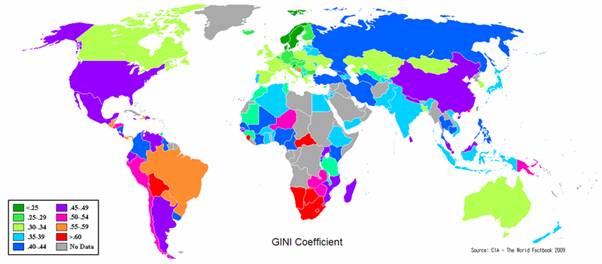Lorenz curve and Gini Coefficient
If you would prefer to view this interaction in a new web window, then please follow the link below:
Gini coefficient
If there is a completely equal distribution of income, then G=0 (X=0 and X/Y must be 0)and the Lorenz curve is a diagonal line.
The distribution of income becomes more unequal as G increases
and gets closer to 1, and this could occur, for example, if more people
received nothing, as the lower end of the Lorenz curve would move
rightwards along the horizontal axis.
As 100% of the population must receive 100% of total income,
the top right hand end of the Lorenz curve must touch the top right
hand end of the diagonal. However, if the top quintile groups obtain a
higher proportion of income, the Lorenz curve will bulge further to the
right in its upper regions before it reaches the top right hand corner.
In the hypothetical extreme where one person earned all the money and everyone else obtained nothing, the area below the Lorenz curve would disappear and G would be very near to 1. Thus G will lie between 0 and 1, and the greater it is, the more the inequality.
The higher the Gini coefficient, the more unequally income is distributed.

World Gini Coefficients 2009 (CIA World Factbook)
As economies grow and develop, income distribution is likely to widen. As economies grow, they tend to reward the economically strong rather than the weak. The rich get richer while the poor get poorer. In most developed economies, progressive tax systems and social security systems exist to help those at the bottom of the economic pile to varying degrees. However, many developing economies do not have the institutional framework required to achieve this redistribution and as a result, income distribution will often worsen during the process of economic growth.
An unequal distribution of wealth and income can act as a barrier to growth. Those on the lowest income levels often have the highest marginal propensity to consume and if they get an increase in their incomes, they are likely to spend most of this, if not all. This additional demand will help drive economic growth. However, if growth simply means that the rich get richer (and perhaps even move their money overseas) this will act as a constraint on development.